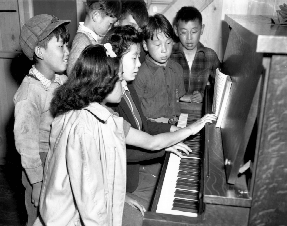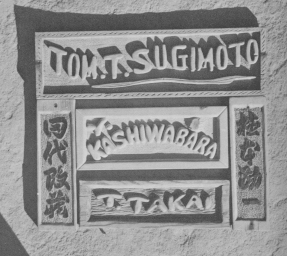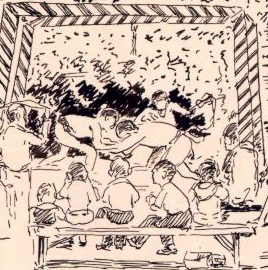Play
If one word was used to describe life at Camp Harmony, perhaps it would be "boring." Camp Harmonotony evidently was a nickname used both within the camp and without. Japanese camp administrators were well aware of the need to build up morale. Robert Hosokawa was named Morale and Recreation Officer and Chick Uno as Athletic Officer for the camp. Under these men were the individual area recreation and athletic directors. Their goal was to build morale by providing a recreational program which would occupy and entertain the inmates of the camp.
The recreational program included weekly dances (Sadie Hawkins, dances for married couples, parties for mess hall workers), art classes and shows, film showings (both commercial and informational) and crafts classes. Bands and theatrical troupes formed. Sports of all kinds pitted players from each area in sumo, softball, volleyball and even golf. Local churches set up choirs and religious classes.
A perusal of the Camp Harmony Newsletter gives a good idea of the array of recreational activities promoted within the camp.
|
Seattle Post-Intelligencer Collection.Museum of History and Industry, Seattle, Washington. |
|
|
"Center Asks for Recreation Aids: All Kinds of Equipment to be Needed; Games Should be Provided for All." Japanese American Courier,, April 24, 1942, page 4. |
Recreational equipment of all kinds and clothing will be badly needed at the Puyallup Reception Center and an appeal is being made for contributions. They should be taken to JACL headquarters, 517 Main Street. Following are some suggestions:
|
|
"Movie Program Includes Eight Feature Pictures."Camp Harmony Newsletter, July 18, 1942. |
Four star movies of recent showings will be running soon in the area movie houses, Rube Hosokawa, supervisor of recreation said today. "Foreign Correspondent" is the first full-lengther of a series of eight motion pictures that are on the recreation schedule. "Our Town", "House Across the Bay", "Son of Monte Cristo", "New Wine", "Cheers for Miss Bishop", "Housekeeper's Daughter" and "Twin Beds" are coming attractions. Starring in "Foreign Correspondent" are Joel McCrea, Laraine Day and Herbert Marshall. The picture will be shown in the different areas from July 20 to the 25. It is a fast moving drama of espionage and fifth-column activity. Directed by Alfred Hitchcock, the picture is packed with suspense. |
|
"The beauty of hand-carved name plates, some using both English letters and Japanese characters, did a little to alleviate the starkness of barracks entrances. Granada, Colo., 1945." Photograph in United States. War Relocation Authority. Impounded People; Japanese-Americans in the Relocation Centers. Tucson: University of Arizona Press, 1969. pg. 94. |
|
|
"Carving Names Becomes Favorite Camp Diversion." Camp Harmony Newsletter, June 25, 1942. |
He is carving names out of wood, that is if he lives in any of Camp Harmony's four areas. Carving names out of wood has become the current hobby of the 'haba-haba' boys, and also boys that are not 'haba-haba.' Virtually every boy with a whittling urge and a boy scout knife is now engaged in carving his or his girl's name out of wood. There is a rumor that in Area A, one boy has even gnawed at a piece of timber until it resembled -- Masakatsu. The usual procedure followed by the 'little shavers' is selection, whittling, sandpapering and finishing. Selection of wood is important. According to veteran whittlers, the wood must be soft, easy to cut, and even grained. Whittling depends upon the skill of the individual. Some unique and intricate names have been wrought out of a hunk of kindling, while on the other hand some names look like a hunk of kindling. |
|
"Gals Hunt Boys." Camp Harmony Newsletter, July 18, 1942. |
This Saturday is not a common, old, ordinary Saturday. Not for the girls of D, anyway. It is "Sadie Hawkin's Day," which in Lil' Abner's Skunk Hollow means that a girl may grab any boy of her choice, and he cannot resist. The same procedure will rule in Jimmie Sakamoto's Skunk Hollow, only the victimized male will be taken to a dance instead of "Marrryin' Sam." Hunting time for the Sadie Hawkin's dance, sponsored by the art department started at 5 p.m. Friday and will end at 7 p.m. today. Programs for the dance may be obtained at the Information Office. Koichi Hayashi's Mountaineers will set up the cone-pone. |
|
"Sumo Tournament -- Pitcher Field." Dated July 4, 1942. Eddie Sato Sketchbook and Drawings. UW Libraries Special Collections. |
|
|
"Sumo-Tories from 'D' Sparkle." Camp Harmony Newsletter, July 18, 1942. |
Sweeping 10 matches during the class A round, Area D's sumo battlers romped off with the major honors of the day during the mammoth sumo "taikai" held in Area D last Sunday. A crowd which filled every nook and cranny surrounding the area around the sumo pit saw 150 "sumo-toris" from all four areas smother each other from morning til after dinner hours. Highlights of the "taikai" took place at 8 p.m. when "sanyaku" matsmen from Area D took on four sumo stars from Area A and B. Area D garnered the first three matches when Saddle Baba tossed "Beefo" Amabe of A, Mits Yano nudged Kiyohara of B and Tom Hirai outlasted Yamamoto of B. But in the bout of the evening, "Arribo" Yanagimachi of D battled Mits Mizuki of A to a draw. All in all, Area D waltzed off with 10 matches during the evening. |


